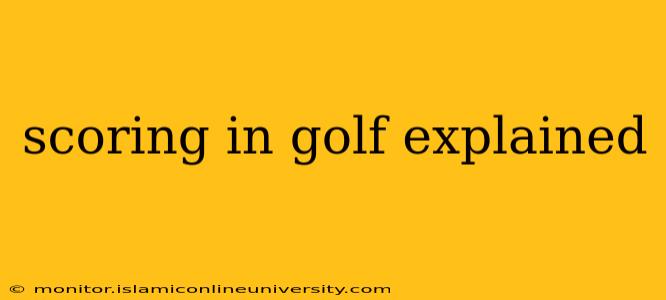Golf scoring might seem confusing at first glance, but understanding the basics is key to appreciating the game. This comprehensive guide will break down how scores are calculated, common terms, and answer frequently asked questions.
What is Par in Golf?
Par is the standard number of strokes an expert golfer should take to complete a hole. Each hole's par is determined by its length and design, typically ranging from 3 (a short hole, also known as a par 3) to 5 (a long hole, a par 5), with most holes being par 4. The total par for a golf course is the sum of the par for each individual hole. Understanding par is fundamental to understanding your score.
How is a Golf Score Calculated?
Your score is the total number of strokes you take to complete a round of golf (typically 18 holes). This number is then compared to the course's par to determine your score relative to par.
- Under Par: If you complete the round in fewer strokes than the course par, your score is expressed as "under par." For example, a score of 70 on a par-72 course is 2 under par (-2).
- Over Par: If you take more strokes than the course par, your score is expressed as "over par." A score of 78 on a par-72 course is 6 over par (+6).
- Even Par: If your score matches the course par, your score is "even par" or "par."
Common Golf Scoring Terms
- Bogey: One stroke over par on a hole.
- Double Bogey: Two strokes over par on a hole.
- Triple Bogey: Three strokes over par on a hole.
- Birdie: One stroke under par on a hole.
- Eagle: Two strokes under par on a hole.
- Albatross (or Double Eagle): Three strokes under par on a hole.
Understanding these terms helps golfers communicate their performance concisely. For example, a golfer might say, "I had a birdie on the 10th and a bogey on the 18th."
What are the Different Ways to Score in Golf?
While the basic scoring method involves counting strokes, there are a few nuances:
- Match Play: In match play, golfers compete hole by hole. The winner of each hole earns a point. The golfer with the most points at the end wins the match, regardless of their total stroke count.
- Stroke Play: This is the most common format, where the total number of strokes taken over a round (or multiple rounds) determines the winner. The golfer with the lowest total score wins.
How Do I Improve My Golf Score?
Improving your golf score involves practice and strategic planning. Focus on these areas:
- Consistent Practice: Regular practice on your short game (chipping and putting) and long game (driving and iron shots) is crucial.
- Course Management: Strategically selecting clubs and shots based on the course layout and your abilities.
- Improving Your Technique: Working with a golf professional to identify and correct swing flaws.
- Mental Game: Maintaining focus and managing pressure on the course.
What are some tips for keeping score?
Accurate scorekeeping is vital. Use a scorecard provided by the course and diligently record each stroke. If you're unsure about a rule, consult a fellow golfer or a course official.
How is a golf handicap calculated?
A golf handicap is a numerical representation of a golfer's skill level, allowing players of different abilities to compete fairly. It's calculated based on a golfer's scores over a specified period, typically using a formula that considers their best scores and adjusts for the course difficulty. The lower the handicap, the better the golfer. Many golf courses and leagues utilize handicaps to create fair competition.
This guide provides a solid foundation for understanding golf scoring. By grasping these core concepts, you can better follow and appreciate the nuances of this engaging and challenging sport. Remember, consistent practice and a strategic approach will lead to improved scores and increased enjoyment of the game.
